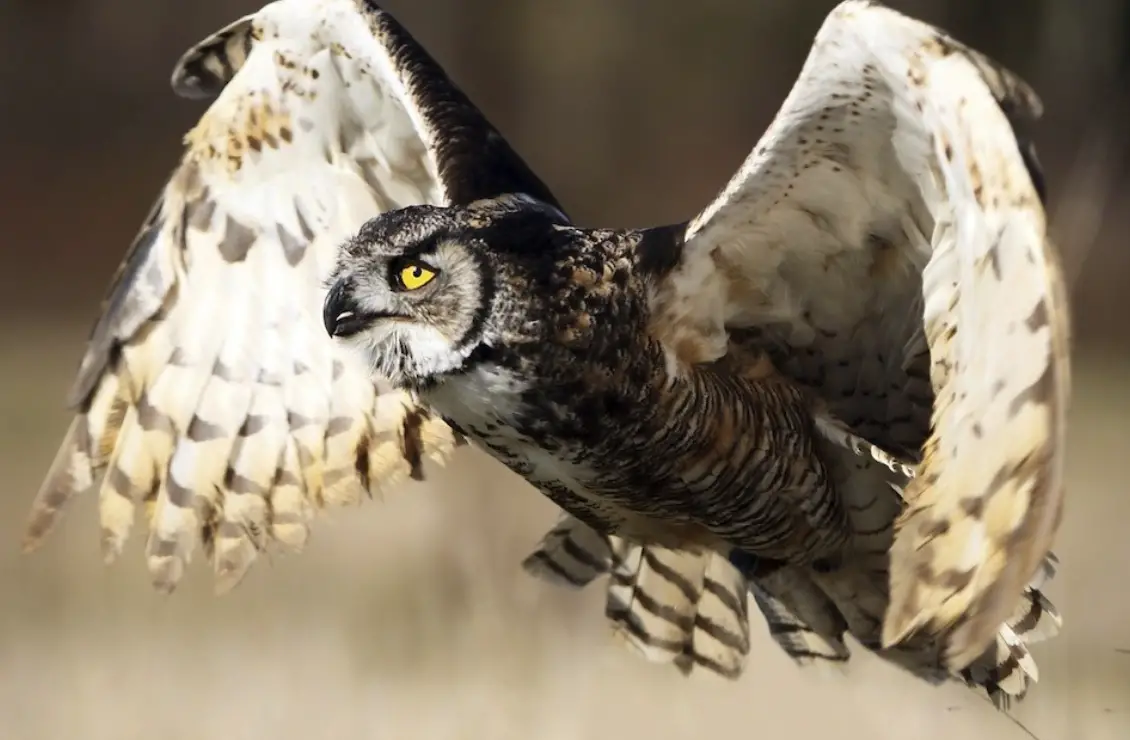There are many different types of owls that can be found in Indiana. While all owls are predators, they vary in their hunting techniques and diet. Some of the most common owls in Indiana include the barn owl, great horned owl, eastern screech owl, and long-eared owl. Each of these owls has unique characteristics that make them special. In this blog post, we will discuss the habits and appearance of each type of owl commonly found in Indiana!
The data was attained from reputable sources and verified by an ornithologist.
Most Common Owls in Indiana
Barn Owls
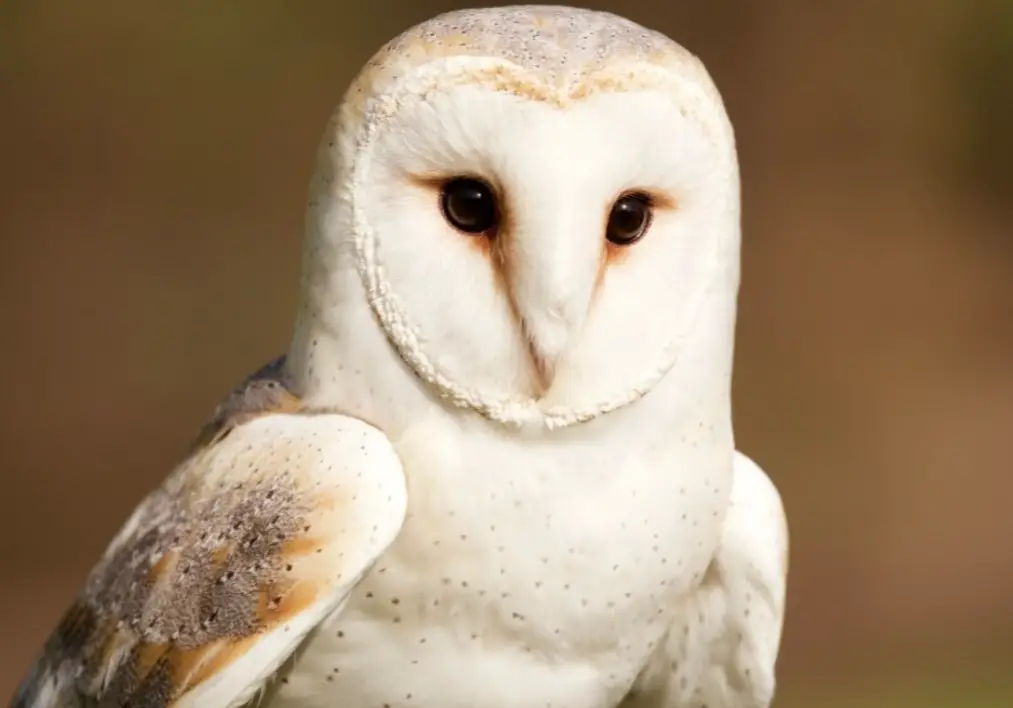
Barn owls are one of the most easily recognizable owl species due to their distinct facial disc and heart-shaped facial appearance. They range in size from about 11 to 21 inches in length with a wingspan of up to four feet.
Females are usually larger than males. Barn owls are found throughout the world except for Antarctica and prefer habitats with an abundance of trees for perching and nesting.
In North America, they are most commonly found in open farmland or grassland areas.
Diet: Barn owls primarily hunt small mammals such as voles, mice, and shrews. They will also eat birds, reptiles, amphibians, and invertebrates. Owls are opportunistic hunters and will take advantage of whatever prey is most abundant in their area.
Behavior: Barn owls are mostly nocturnal but can also be seen hunting during the day. They hunt by flying low to the ground and using their sharp vision and hearing to locate prey. Owls are silent flyers which helps them to sneak up on their unsuspecting prey.
Once they have located their target, they will swoop down and grab it with their sharp talons. Barn owls typically mate for life and will use the same nest site year after year. Females will lay between two and six eggs per clutch and incubate them for about 30 days.
The male will bring food to the female during this time. After the eggs hatch, both parents will help to raise the young owls.
Barn owls can live up to 20 years in the wild but most only live for about four or five years due to predation and human-related mortality factors.

Related article: Types of Owls in Oregon
Eastern Screech-Owl
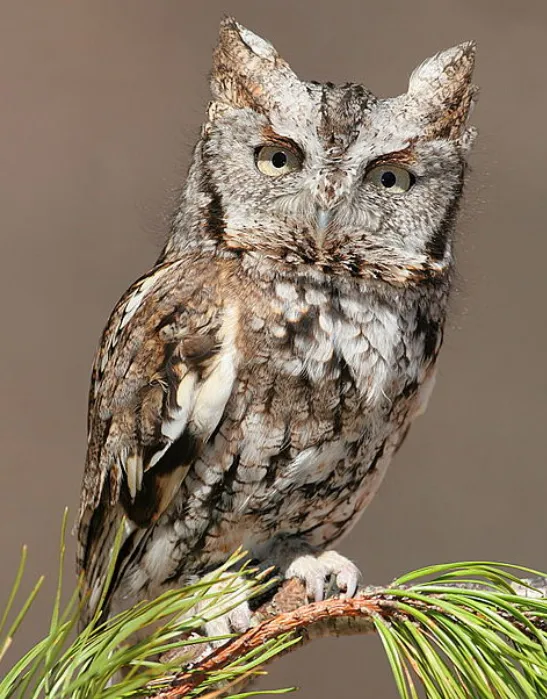
The Eastern Screech-Owl is a small owl. Adults are about nine inches long and have a wingspan of about two feet. They can be found in a variety of colors, including gray, brown, and red. The most common color is gray. These owls are nocturnal, meaning they are most active at night.
Eastern Screech-Owls eat small mammals, such as mice and voles. They also eat reptiles, birds, and insects. These owls hunt from a perch, watching for prey before swooping down to capture it.
Eastern Screech-Owls live in wooded areas across the eastern United States. They nest in cavities in trees, often using old woodpecker holes. These owls are non-migratory, meaning they stay in the same area year-round.
Eastern Screech-Owls are relatively quiet birds. The most common call is a trill that sounds like “kree-kree-kree.” These calls are often used to communicate with mates or announce their presence to other owls.

Northern Saw-Whet Owl
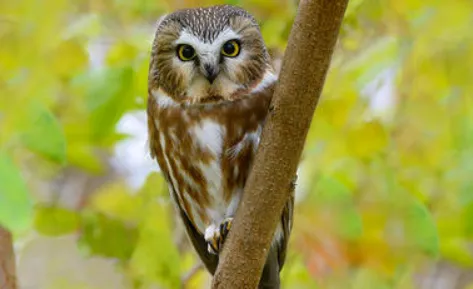
The Northern Saw-Whet Owl is a medium-sized owl. They have a wingspan of about 16 to 20 inches and they are about 14 inches tall. The males and females look similar, but the males are usually slightly smaller than the females. They have brown and white feathers with some black streaks. Their eyes are yellow and they have a black beak.
Their diet consists mostly of small rodents, such as mice and voles. They will also eat birds, reptiles, and insects.
They nest in trees, often near water. They will also use man-made structures, such as buildings or bridges. Their nesting material is usually made up of twigs, leaves, and grass.
They are nocturnal, which means that they are active at night. During the day, they roost in trees or on buildings.
If you see Northern Saw-Whet Owls in Indiana, they are most likely during the winter months. They typically arrive in Indiana in October and stay until April. These owls are not usually found in heavily forested areas but can be found in open woodlands, farmland, and even suburban areas.
If you are lucky enough to see a Northern Saw-Whet Owl, you will likely hear them before you see them. They have a distinct call that sounds like “whee-oo” or “too-wit”. They also make a sound that is often described as a cat meowing.

Long-eared Owls
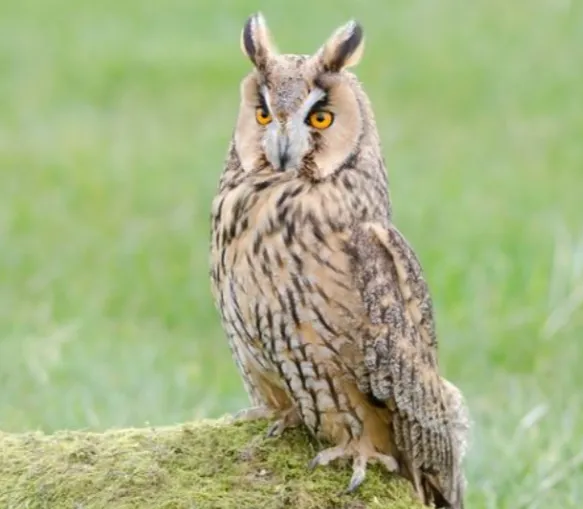
The long-eared owl is a medium-sized owl with large ear tufts. It has yellow eyes and a dark beak. The upper parts are brown with white spots, while the underparts are pale with brown streaks.
These owls hunt at night, preying on small mammals such as voles and mice. They nest in trees, often using the abandoned nests of other birds. Long-eared owls are found in woodlands throughout North America.
The long-eared owl is a medium-sized owl with large ear tufts. It has yellow eyes and a dark beak. The upper parts are brown with white spots, while the underparts are pale with brown streaks.
These owls hunt at night, preying on small mammals such as voles and mice. They nest in trees, often using the abandoned nests of other birds. Long-eared owls are found in woodlands throughout North America.
Long-eared owls are relatively easy to identify due to their large ear tufts. They are also one of the few owl species that are active during the day. These owls typically hunt at night, but they will occasionally hunt during the day if there is enough light. Their diet consists mostly of small mammals such as voles and mice.
Long-eared owls nest in trees, often using the abandoned nests of other birds. Their nest sites are typically in woodlands, but they can also be found in urban areas. Long-eared owls are found throughout North America.

Great Horned Owls
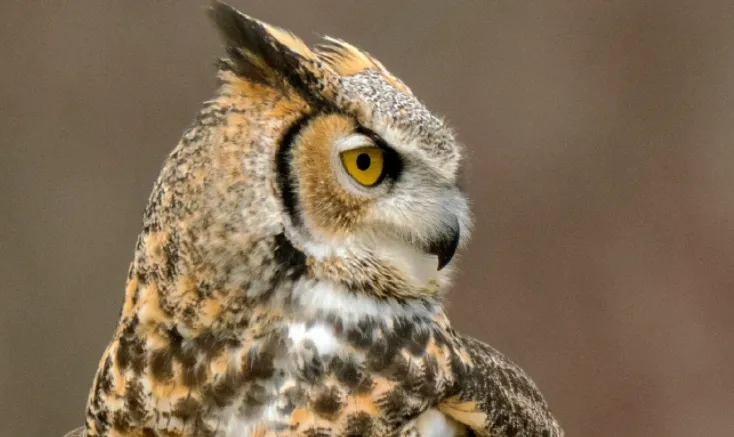
Great Horned Owls are the largest owl in North America, and one of the most widespread. They’re found in every Canadian province and territory, all 48 contiguous U.S. states, and Mexico.
Adults have large, prominent ear tufts, which are actually feathers. The facial disc is also feathery and tawny in color, with a dark rim. There’s a large, dark “Y” or “V” shaped mark on the chest.
These owls hunt at night, and will eat just about anything they can catch: rodents, rabbits, hares, other birds up to the size of geese. They’ve even been known to take skunks, snakes, and bats.
Great Horned Owls are 17-25 inches long, with a wingspan of up to 60 inches. They can weigh up to three pounds.
These owls don’t build their own nests. Instead, they’ll take over the nests of other birds, or use a natural cavity in a tree. They’re found in woods, forests, deserts, and even urban areas.
Great Horned Owls are generally silent, but they can make a loud, low hooting sound: “hoo hoo hooooo.” They also hiss, grunt, and make other noises.

Short-eared Owl
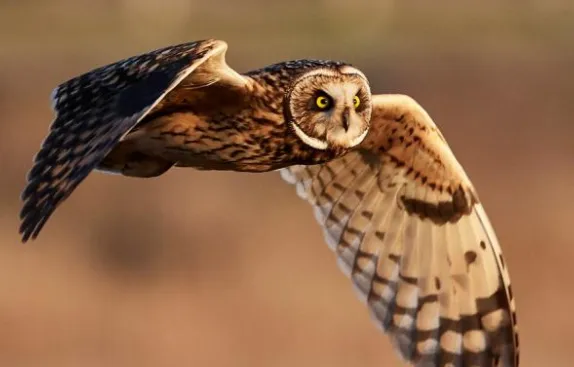
Short-eared Owls are one of the most widespread owl species in North America, but they are also one of the least studied. These medium-sized owls can be found in a variety of habitats, from open grasslands to tundra. Although they are not as common in Indiana as in some other states, Short-eared Owls can occasionally be found in the state during the winter months.
Short-eared Owls are relatively easy to identify thanks to their distinctive appearance. These owls have large, round heads and no ear tufts. Their plumage is mostly brown with white streaks and spots, and they have long barred tails. Short-eared Owls are also one of the few owl species that are active during the day.
Short-eared Owls primarily eat small mammals, such as mice and voles. They will also occasionally eat birds, reptiles, and insects. These owls hunt by perching on a high vantage point and watching for movement below. They will then swoop down to capture their prey with their sharp talons.
Short-eared Owls typically nest on the ground, often in open areas such as fields or meadows. The female will lay a clutch of anywhere from three to seven eggs, which she will incubate for about three weeks. Once the chicks hatch, they will be cared for by both parents and will fledge at around six weeks old.

American Barn Owl
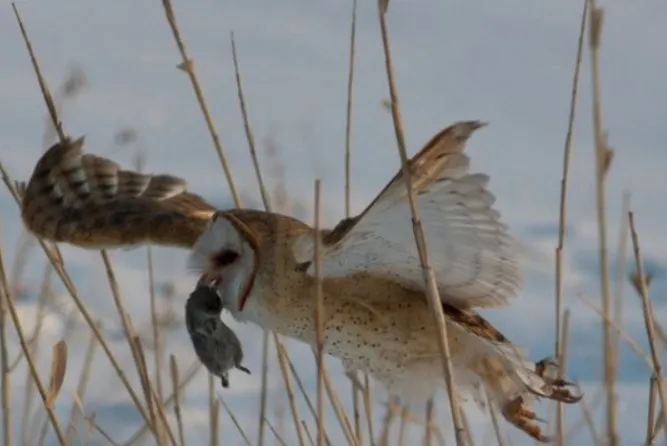
The American Barn Owl is a medium-sized owl with a large, rounded head and no ear tufts. The upperparts are grayish brown, streaked with white. The underparts are pale gray, heavily streaked with black.
The face is white with a black mask that extends over the eyes to the base of the beak. The beak is black, and the eyes are dark brown. The legs and feet are covered with pale gray feathers.
The American Barn Owl feeds primarily on small mammals, such as mice, rats, and voles. It will also eat birds, reptiles, amphibians, and invertebrates. The owl hunts at night by perching on a high vantage point and scanning the ground for prey. When it spots an animal, it swoops down and seizes it with its sharp talons.
The American Barn Owl is found in open habitats across North and South America. These owls in Indiana can be found in farmland, grasslands, and marshes. The owl nests in tree cavities, old buildings, and nest boxes.
The American Barn Owl is a nocturnal bird of prey. It roosts during the day in trees, barns, or other sheltered locations. At night, it hunts for food. The owl is most active on moonlit nights. During the breeding season, the male owl performs a flight display in which it circles over its territory and calls to advertise its presence to potential mates.
The female owl usually lays two to six eggs in a nest located in a tree cavity, old building, or nest box. The young owls fledge (leave the nest) at about seven weeks of age. After they leave the nest, they are cared for by their parents for another two to three months. After that, they are on their own.

Barred Owl
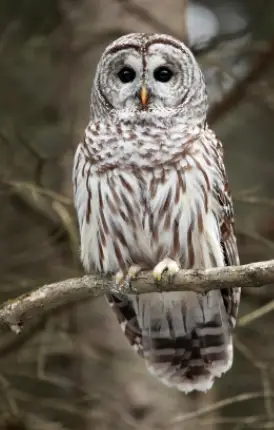
The Barred Owl is a medium-sized owl with a large, rounded head and no ear tufts. It has brown eyes and a yellow beak. The upperparts are gray with brown bars and the underparts are white with black streaks. The wings are long and broad. The tail is short and square.
This owl is found in wooded areas across North America. It prefers forests with dense vegetation and lots of trees for roosting and nesting. The Barred Owl hunts at night for small mammals, reptiles, and birds. It perches on a branch or in a tree and watches for prey before swooping down to capture it with its talons.
The Barred Owl is a non-migratory bird. It is active at night and sleeps during the day. During the breeding season, males will hoot to attract a mate. The female will build a nest of twigs in a tree cavity or old nest of another bird species.
She lays two to four eggs and incubates them for 28-33 days. The young owls fledge at around 40 days old but will stay with their parents until they are independent at around four to five months old.
The lifespan of a Barred Owl in the wild is unknown but captive birds have been known to live for over 20 years. In Indiana, this owl is found in the southern and central parts of the state. It is most active in the evening and at night. During the day, it roosts in trees or dense vegetation.
The Barred Owl can be found in woodlands, forests, parks, and gardens. When hunting, it will perch on a branch or in a tree and watch for prey. It will then swoop down and capture its prey with its talons.
The diet of the Barred Owl consists of small mammals, reptiles, birds, and insects. In Indiana, common prey items include mice, voles, shrews, snakes, frogs, and crayfish. The Barred Owl hunts at night and can be seen flying low over the ground or sitting on a branch watching for prey. It will also eat carrion.

Snowy Owl
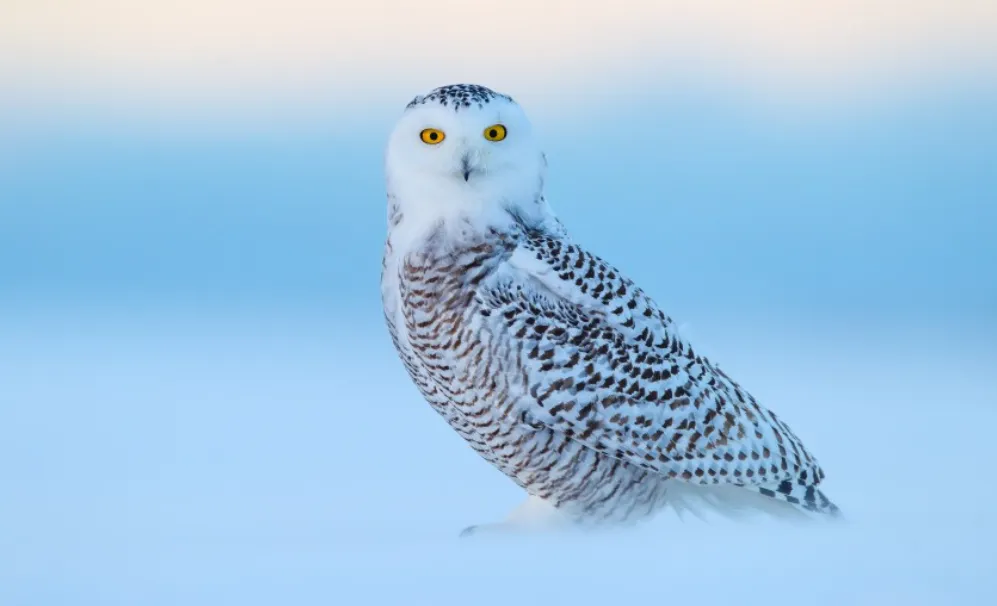
The Snowy Owl is a large, white owl of the typical owl family. Snowy Owls are native to Arctic regions in North America and Eurasia. Male owls are almost all white, while females have more flecks of black plumage.
Snowy Owls hunt during the day and night. They typically eat lemmings, voles, and other small rodents.
An adult Snowy Owl may be nearly 24 inches long and have a wingspan of up to 60 inches.
Snowy Owls live in open tundra habitats during the breeding season. In the winter, they may be found in more open areas, including airports.
Snowy Owls are generally silent, but they may make a variety of sounds including hoots, hisses, and screams.

What is the most common owl in Indiana?
The most common owl in Indiana is the barn owl.
What kind of owls does Indiana have?
The most common owl in Indiana is the barn owl, but other common owls include the great horned owl, eastern screech owl, and long-eared owl.
Where are owls found in Indiana?
Owls can be found in wooded areas, forests, and open fields throughout Indiana.
How do you attract owls in Indiana?
Owls can be attracted to nesting and roosting boxes placed in wooded areas. You may also attract owls by placing a dead mouse or other small mammals in an open area as bait.

An avid ornithologist, zoologist and biologist with an unwavering passion for birds and wild animals.
Dr. Wilson’s journey in ornithology began in childhood and led him to obtain a Ph.D. in Ornithology from the prestigious Avian Research Institute. He has worked closely with renowned experts in the field and conducted extensive research and field studies globally.

